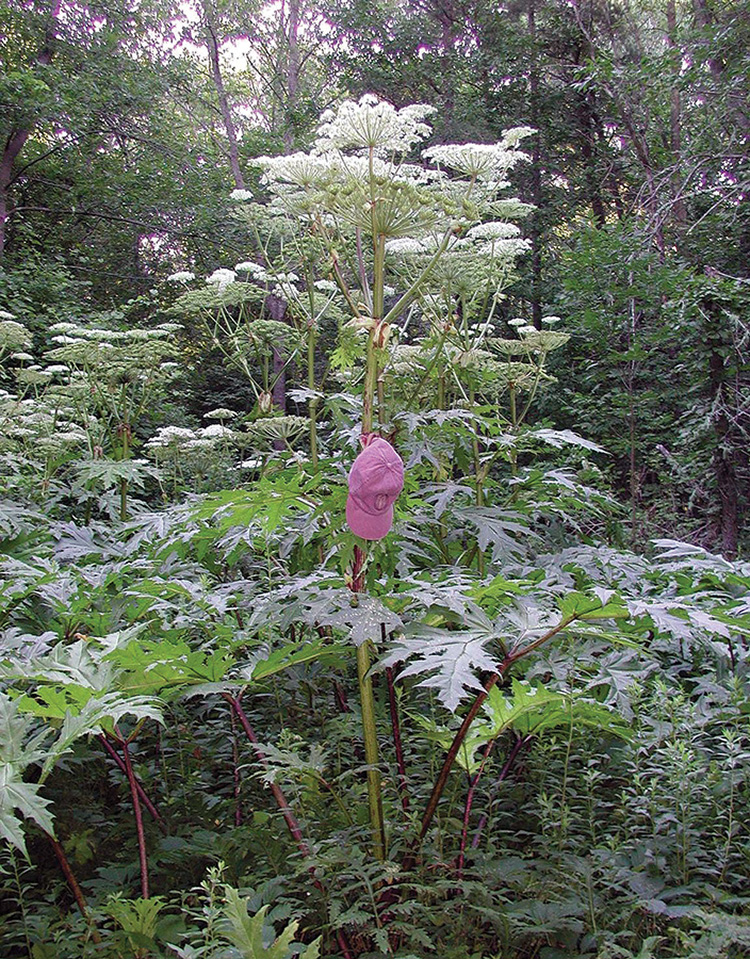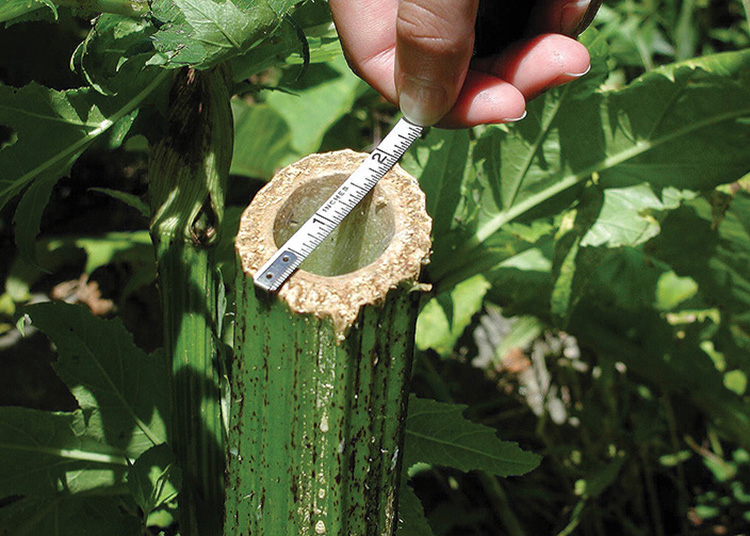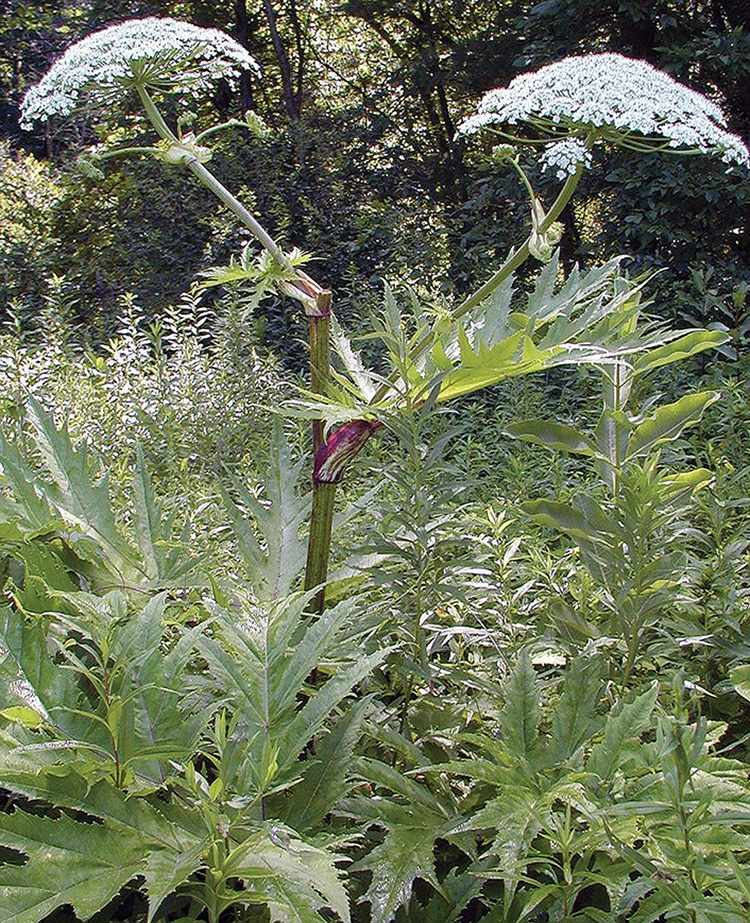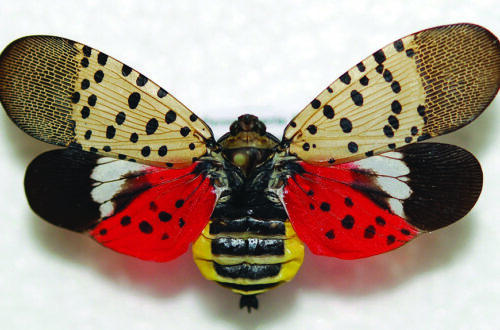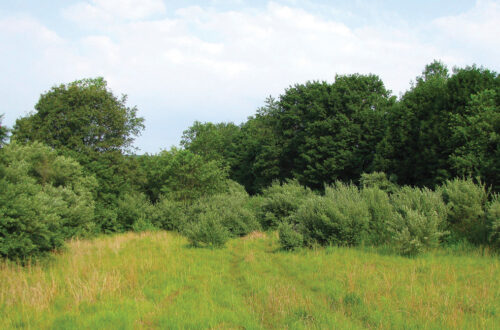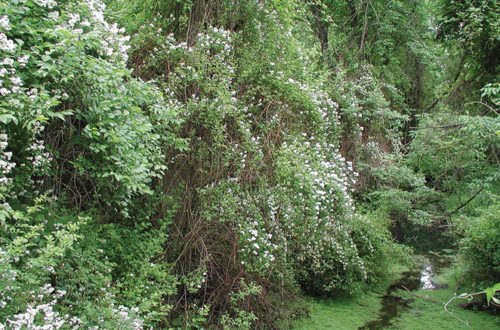
MARCH-APRIL 2018 – Giant hogweed (Heracleum mantegazzianum) is aptly named. This monster can grow to a height of 20′ and is some-times described as Queen Anne’s lace on steroids.
Giant hogweed is a member of the carrot family (Apiaceae) and is native to the Caucasus Mountains in Western Asia, between the Black Sea and the Caspian Sea.
It was brought to England and planted at Kew Gardens as an ornamental in the late 1800s and subsequently spread to other parts of the world. It’s considered invasive in Connecticut and is listed as a federal noxious weed in the U.S.
According to the Connecticut Invasive Plant Working Group (CIPWG) it was first discovered in Connecticut in 2001 during a survey funded by UConn and the USDA. At last count, it’s been reported in 26 of Connecticut’s 169 municipalities.
Oddly, the English progressive rock band Genesis wrote and recorded a song titled The Return of the Giant Hogweed. Here’s a random sample …
Long ago in the Russian hills,
A Victorian explorer found the regal
Hogweed by a marsh,
He captured it and brought it home.
Botanical creature stirs,
seeking revenge
Royal beast did not forget
Soon they escaped,
spreading their seed
Preparing for an onslaught,
threatening the human race
The dance of the giant hogweed
Mighty hogweed is avenged
Human bodies soon will know
our anger
Kill them with your hogweed hairs
Heracleum mantegazziani
Giant hogweed lives
Don’t Touch This Plant – Seriously!
In truth, this plant really is a monster. Not only because it’s large and invasive, but also because it’s a public health hazard. The clear, watery sap contains furocoumarins that are phototoxic and can bind with DNA, proteins and lipids.
When contacted skin is exposed to sunlight, in the presence of moisture (sweat), it can cause phytophotodermatitis. Basically, it can make your skin hypersensitive to ultraviolet light.
Some sources say all you have to do is touch or brush against the plant. If you think your skin has contacted the plant, especially the sap, wash the affected area immediately with soap and cold water and keep it out of the sun for a couple of days.
In susceptible people, reactions can be severe and include blisters and even long-lasting brown or purplish scars. These symptoms can occur hours or days after exposure. If you’re unsure, it’s a good idea to seek medical advice. Waiting for symptoms to develop could make matters worse.
There is disagreement about whether the sap can cause temporary or even permanent blindness but, obviously, it’s best to be prudent and use eye protection in the vicinity of this plant.
Habitat
Giant hogweed is found in fallow fields, vacant lots, waste lands and along railroads, roadsides and rights-of-ways, often in disturbed soils. It prefers rich, moist soil and semi-shade and is often found in dense colonies along stream banks.
Identification
Giant hogweed is an herbaceous biennial or monocarpic perennial that can reach 20′ in height. The hollow stems, which have coarse bristles and purple blotching, can reach 2″-4″ in diameter. The pinnately compound leaves have three leaflets and are arranged alternately. The leaves have stiff hairs and can reach 5′ across. In the first year, young leaves present in a rosette pattern.
It flowers in June and July. The small white flowers are held in large umbrella-shaped inflorescences that can reach 2.5′ across. The fruit is a flat oval or ellipse about 3/8″ long.
Some sources report that giant hogweed has an odor similar to anise.
Reproduction
Giant hogweed reproduces primarily from seed, which germinate throughout the growing season. Each plant can produce 10,000-100,000 seeds. These seeds, which are spread by animals, water and wind, can remain viable in the soil for several years or more.
According to Dr. Jatinder Aulakh, a scientist at the The Ag Station’s Valley Lab in Windsor, “It can be a biennial or a perennial depending upon where it is growing or how much time it takes to start reproductive growth.”
Dr. Aulakh says our local populations are perennials that can take three or more years to develop and flower. The plant typically dies once it produces flowers that reach maturity but that may not always be the case because vegetative reproduction from buds and overwintering tuberous roots is also possible.
It’s considered invasive because of its size, prolific seed production, rapid growth and tendency to form dense colonies that crowd out native species. When it dies back, it leaves bare ground that increases the chance of erosion of slopes and stream banks.
Look-alikes
Giant hogweed is most often confused with cow parsnip (Heracleum lanatum). Cow parsnip is a native plant that resembles giant hogweed in some ways but is smaller in all regards, reaching only 5′-8′ in height. The leaves are only 2.5″ wide and the flower heads are also smaller. Cow parsnip tends to flower in early June, before giant hogweed.
Other look-alikes include purple-stemmed Angelica (Angelica atropurpurea), poison hemlock (Conium maculatum), wild parsnip (Pastinaca sativa), Queen Anne’s lace (Daucus carota) and pokeweed (Phytolacca americana). Note that wild parsnip can also cause similar skin problems.
Control & Management
We hesitate to recommend removal/ eradication methods here because it’s a potentially dangerous undertaking that requires a number of precautions.
At a minimum, use protective clothing, water-proof gloves and eye and face protection if you attempt to cut or remove this plant.
Check out the CIPWG website at cipwg.uconn.edu for more information.
– Will Rowlands
